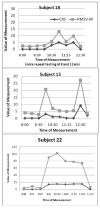Objective measurement of dyskinesia in Parkinson's disease using a force plate
- PMID: 20213818
- PMCID: PMC3148105
- DOI: 10.1002/mds.22856
Objective measurement of dyskinesia in Parkinson's disease using a force plate
Abstract
Clinical investigation of levodopa-induced dyskinesia (LID) in Parkinson's disease (PD) is limited because of lack of objective measurements and no consensus on use of a standard measuring tool. Currently, clinical trials use subject-completed diaries of dyskinesia throughout the day or investigator-administered clinical rating scales. An objective and valid method of measuring LID would reduce bias, variability, and decrease the time and number needed in trials of potential anti-dyskinetic agents. We have investigated using a force plate under standing subjects, which records movement of the center of pressure (CoP) to quantify LID over a levodopa (L-dopa) cycle. Twenty-two PD subjects (15 with LID, 7 without LID) admitted to an inpatient research facility had their PD meds withheld overnight, followed by a 2 hours intravenous L-dopa infusion the next day. The root mean squared of the velocity in the anterior-posterior direction (RMSV) derived from an analysis of the CoP, and, the modified Abnormal Involuntary Movement Scale (mAIMS) were performed repeatedly for 6 hours, initially as subjects were OFF before the infusion, through infusion until OFF again. There was a high correlation between the area under the curve (AUC) of the mAIMS and the RMSV within and between subjects. As a measure of LID, RMSV had excellent validity and reliability between subjects, and using a force plate was feasible. Sensitivity to changes in LID was initially demonstrated but should be repeated. Thus, CoP recordings on a force plate can objectively quantify LID in PD and may be very useful in clinical trials or other investigations of dyskinesia.
(c) 2010 Movement Disorder Society.
Figures





Similar articles
-
Vision-based assessment of parkinsonism and levodopa-induced dyskinesia with pose estimation.J Neuroeng Rehabil. 2018 Nov 6;15(1):97. doi: 10.1186/s12984-018-0446-z. J Neuroeng Rehabil. 2018. PMID: 30400914 Free PMC article. Clinical Trial.
-
Quantitative assessment of levodopa-induced dyskinesia using automated motion sensing technology.Annu Int Conf IEEE Eng Med Biol Soc. 2012;2012:154-7. doi: 10.1109/EMBC.2012.6345894. Annu Int Conf IEEE Eng Med Biol Soc. 2012. PMID: 23365855 Clinical Trial.
-
Cerebrospinal fluid levels of catecholamines and its metabolites in Parkinson's disease: effect of l-DOPA treatment and changes in levodopa-induced dyskinesia.J Neurochem. 2017 May;141(4):614-625. doi: 10.1111/jnc.13997. Epub 2017 Mar 30. J Neurochem. 2017. PMID: 28244186
-
Levodopa-induced dyskinesia in Parkinson's disease: epidemiology, etiology, and treatment.Curr Neurol Neurosci Rep. 2007 Jul;7(4):302-10. doi: 10.1007/s11910-007-0046-y. Curr Neurol Neurosci Rep. 2007. PMID: 17618536 Review.
-
Safety and Efficacy of Levetiracetam for the Management of Levodopa- Induced Dyskinesia in Patients with Parkinson's Disease: A Systematic Review.CNS Neurol Disord Drug Targets. 2019;18(4):317-325. doi: 10.2174/1871527318666190314101314. CNS Neurol Disord Drug Targets. 2019. PMID: 30868968
Cited by
-
A Public Data Set With Ground Reaction Forces of Human Balance in Individuals With Parkinson's Disease.Front Neurosci. 2022 Apr 19;16:865882. doi: 10.3389/fnins.2022.865882. eCollection 2022. Front Neurosci. 2022. PMID: 35516808 Free PMC article. No abstract available.
-
Trunk accelerometry reveals postural instability in untreated Parkinson's disease.Parkinsonism Relat Disord. 2011 Aug;17(7):557-62. doi: 10.1016/j.parkreldis.2011.05.010. Epub 2011 Jun 8. Parkinsonism Relat Disord. 2011. PMID: 21641263 Free PMC article.
-
Sensory Re-weighting for Postural Control in Parkinson's Disease.Front Hum Neurosci. 2019 Apr 17;13:126. doi: 10.3389/fnhum.2019.00126. eCollection 2019. Front Hum Neurosci. 2019. PMID: 31057379 Free PMC article.
-
The Human Experience with Intravenous Levodopa.Front Pharmacol. 2016 Jan 6;6:307. doi: 10.3389/fphar.2015.00307. eCollection 2015. Front Pharmacol. 2016. PMID: 26779024 Free PMC article. Review.
-
Effect of augmenting cholinergic function on gait and balance.BMC Neurol. 2015 Dec 23;15:264. doi: 10.1186/s12883-015-0523-x. BMC Neurol. 2015. PMID: 26697847 Free PMC article. Clinical Trial.
References
-
- Pechevis M, Clarke CE, Vieregge P, Khoshnood B, schaseaux-Voinet C, Berdeaux G, Ziegler M. Effects of dyskinesias in Parkinson's disease on quality of life and health-related costs: a prospective European stud. Eur J Neurol. 2005 Dec;12(12):956–63. - PubMed
-
- Fabbrini G, Brotchie JM, Grandas F, Nomoto M, Goetz CG. Levodopa-induced dyskinesias. Mov Disord. 2007 Jul;22(10):1379–89. - PubMed
-
- Grandas F, Galiano ML, Tabernero C. Risk factors for levodopa-induced dyskinesias in Parkinson's disease. J Neurol. 1999 Dec;246(12):1127–33. - PubMed
-
- Volkmann J. Deep brain stimulation for Parkinson's diseas. Parkinsonism Relat Disord. 2007;13 3:S462–S465. - PubMed
Publication types
MeSH terms
Substances
Grants and funding
LinkOut - more resources
Full Text Sources
Medical
Research Materials

